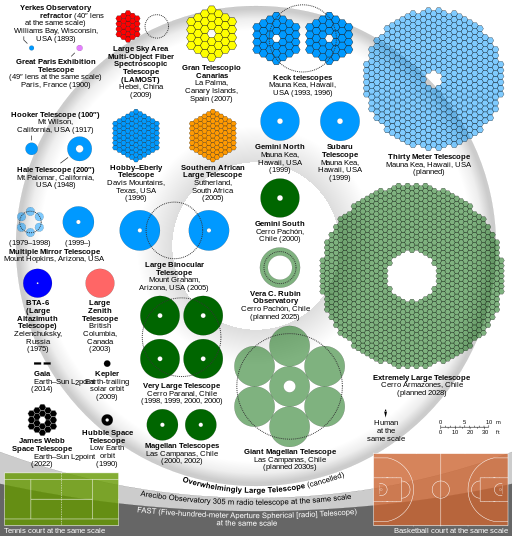File:Comparison optical telescope primary mirrors.svg

Original file (SVG file, nominally 512 × 536 pixels, file size: 168 KB)
This file is from Wikimedia Commons and may be used by other projects. The description on its file description page there is shown below.
Summary
| DescriptionComparison optical telescope primary mirrors.svg |
[edit subpage] English: Comparison of nominal sizes of primary mirrors of notable optical reflecting telescopes, and a few other objects. Dotted lines show sizes of round mirrors that would have had equivalent light-gathering ability.
The telescopes shown on this comparison chart are listed below, ordered in each sub-section by (effective) mirror/lens area, low to high, and then by actual/planned first light date, old to new. The "present-day" status is given as of the beginning of 2024. See also List of largest optical reflecting telescopes. Largest refractors (for comparison):
Ground-based reflectors:
Space telescopes:
Radio telescopes for comparison:
Other objects for comparison:
|
||||||
| Source | Own work | ||||||
| Author | Cmglee; data on holes in mirrors provided by an anonymous user from IP 71.41.210.146 | ||||||
| Other versions |
|
||||||
| SVG development InfoField | This W3C-invalid diagram was created with Inkscape, or with something else. This diagram is translated using SVG switch elements: all translations are stored in the same file.
|
Licensing
- You are free:
- to share – to copy, distribute and transmit the work
- to remix – to adapt the work
- Under the following conditions:
- attribution – You must give appropriate credit, provide a link to the license, and indicate if changes were made. You may do so in any reasonable manner, but not in any way that suggests the licensor endorses you or your use.
- share alike – If you remix, transform, or build upon the material, you must distribute your contributions under the same or compatible license as the original.

|
Permission is granted to copy, distribute and/or modify this document under the terms of the GNU Free Documentation License, Version 1.2 or any later version published by the Free Software Foundation; with no Invariant Sections, no Front-Cover Texts, and no Back-Cover Texts. A copy of the license is included in the section entitled GNU Free Documentation License.http://www.gnu.org/copyleft/fdl.htmlGFDLGNU Free Documentation Licensetruetrue |
Captions
Items portrayed in this file
depicts
image/svg+xml
80eb7eebb4072cdb3b15c5edd9885fae9970a4a8
171,712 byte
536 pixel
512 pixel
File history
Click on a date/time to view the file as it appeared at that time.
| Date/Time | Thumbnail | Dimensions | User | Comment | |
|---|---|---|---|---|---|
| current | 05:37, 23 February 2024 |  | 512 × 536 (168 KB) | DmitTrix | removed outline on scale’s components, fixed units alignment, added Chinese for units; restored more numeric character references for invisible/indistinguishable characters (such as RTL marks, non-breaking spaces/hyphens); fixed Slovenian where "mirror" was wrongly used instead of "lens"; slightly expanded refractor telescopes’ descriptions in most langs;fixed Tennis court’s text position for Chinese |
File usage
The following 2 pages use this file:
Metadata
This file contains additional information, probably added from the digital camera or scanner used to create or digitize it.
If the file has been modified from its original state, some details may not fully reflect the modified file.
| Short title | Comparison of optical telescope primary mirrors |
|---|---|
| Image title | Comparison of nominal sizes of primary mirrors of notable optical telescopes compared with some other telescopes and objects, by CMG Lee. Dotted lines show mirrors with equivalent light-gathering ability. Thanks to user at 71.41.210.146 for data on holes in mirrors. |
| Width | 100% |
| Height | 100% |









